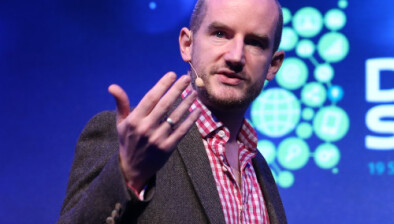Richard Grogan: How to invite discrimination cases without even trying

Richard Grogan
Employment law solicitor Richard Grogan of Richard Grogan & Associates responds to reports about a job advertisement published by a UK celebrity chef.
When it comes to dysfunctional industries, sometimes what comes out of the restaurant industry is so amazing that you would not believe it actually happened.
Recently in the UK, a Michelin-star chef put up an add seeking CVs for a job where the person would be working 45 hours a week and earning £24,000 GBP per year. Applicants were asked to send their CV along with a photo. When challenged on social media, and in particular Twitter, the celebrity chef tweeted:
“For the record photos with a CV is a popular euro thing and it makes it easy to identify people afterwards. It is not a discrimination thing. I don’t care about colour gender or looks…I am not trying to f*** them I just want them to carry plates for me”
This may appear unusual but this was actually reported in the Daily Mail in the UK recently.
As employment solicitors, if a client came to us and said that they were going to ask for CVs and that a photo would be attached, we would immediately be advising them that they were stirring up an avalanche of potential discrimination cases that were going to be difficult to defend.
If a man was chosen, women who applied could claim that really it was a job looking for a man. If an older person was chosen, younger people could claim that really the job was looking for an older person. If a woman was chosen, then there could be claims from men; and if a younger person was chosen, then there could be claims from older people. In reality, where photos are looked for, claims could come from any of the nine grounds under the equality legislation.
The idea that a HR director or manager would look for photos with a CV is really quite amazing. When it comes to putting in a job advertisement, you set out what the job is and what qualifications are being looked for. You can’t use words like “young”. You cannot use any phrase which would be potentially discriminatory. If you are looking for experience, you are going to need to be able to show why experience is needed for the particular job.
When it comes to receiving CVs, many employers will take the step of having the CVs redacted by somebody else in the organisation who will not be involved in reviewing the CVs, to shortlist individuals by effectively taking out any information which could be discriminatory. For example, first names which would indicate whether a person is male or female might be redacted. The date that they left school would be redacted so as to avoid any age issue. The name of a school may be redacted so as to avoid any gender issue.
In reviewing CVs, the issue is to determine whose CVs meet the requirement for the job. The explanation given in relation to the requirement to have a photo was raised in many replies to his tweet and his response was that photos with a CV is a popular euro thing and it makes it easy to identify people afterwards”.
I know of no reason why you would need a photo to identify an applicant for a job. You receive their CV. You shortlist people. You are not going to have them all come at the same time. When they come, they are going to identify themselves to somebody in the workplace. They would be called in or they would be sitting somewhere where you can go out and it will be very easy to know who they are. At that stage you will have CVs that have the person’s name on it, so even if there are a number of people sitting there you can ask for “Mary” or “Mark”. It most definitely is not a “euro thing” that CVs have a photo attached.
There is in reality at times a problem with celebrity chefs. The problem is that they see themselves as a celebrity and therefore in some way not subject to the same constraints as everybody else. Celebrity chefs are very gifted in the area of cooking. Many of them will have very few people skills and certainly many of them will not have any HR experience. In such cases, those who do not have the relevant skills should really stay away from putting up job advertisements and if they want to be seen as the person putting them up on social media, it is advisable that what they put is checked by somebody who actually has some knowledge as to what is appropriate to post.
This particular case may be at the extremes. However, there is a message here. If an employer, whether in the restaurant industry or any other industry, wants to bring down an avalanche of discrimination cases against them, the easiest way to do so is to put in an inappropriate job advertisement. If advertising on social media, a secondary way of getting involved in discrimination cases is to start getting involved in responses on social media as to what your advertisement states.
When considering putting up an advertisement, you finalise it. You sleep on it for 24 or 48 hours. If you don’t have appropriate experience as to what is or is not proper to put in an advertisement for a position, then you get somebody with that experience to check it. You make sure that any advertisement cannot be turned against you to be the catalyst for discrimination claims.
In the alternative, if you really want to give your employment law solicitor a very early Christmas present, then put in an advertisement for a job that requires a potential employee to send a photograph. In reality, an employer who does so opens up the Pandora’s box of discrimination cases based on the argument that the effect of looking for one was that a particular age and gender was being looked for and, in such circumstances, an employer trying to defend such a case will probably be in the position of having to justify why a photo was needed. Certainly the response from the particular employer as regards what he didn’t want them for and did want them for is unlikely to impress any Tribunal.
There are a number of dysfunctional employers. The particular social media tweet looking for a front of house person should have been sent by somebody who knew something about employment rights and advertising. The chef clearly had no such experience. He quite frankly would have been better off staying in the kitchen, where he probably is very well qualified and leave the issue of advertising for and choosing a front of house person to somebody would know how to do it in a proper way.
Quite frankly, as an employment law solicitor, I am appalled that any such advertisement would ever go up and worse still the social media response. When I was asked to comment on the case, I thought I was being sent an April fool’s article.

- Richard Grogan is a partner at Richard Grogan & Associates Solicitors.








